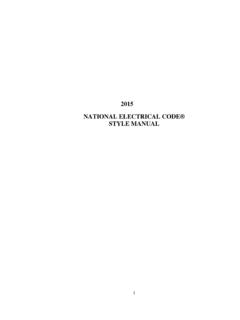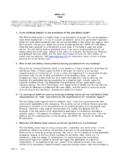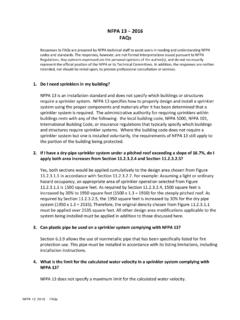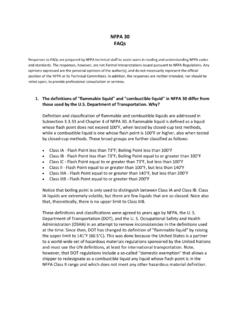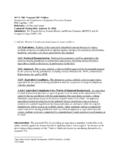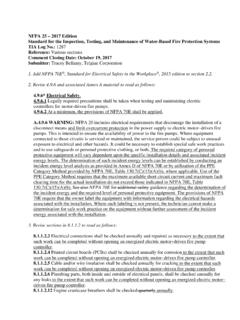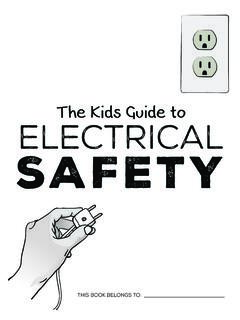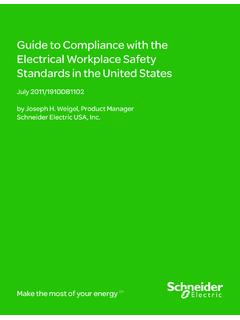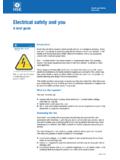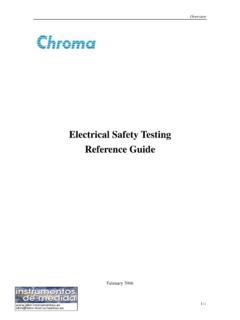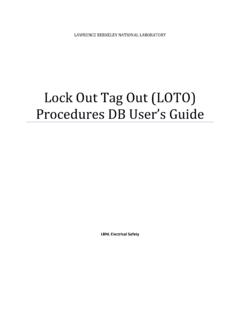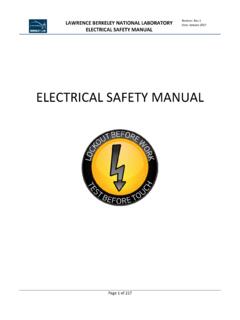Transcription of FALLING BEHIND - nfpa.org
1 FALLING BEHINDon electrical SafetyWide Variations inState Adoptions of theNEC Reveal Neglectof electrical SafetyMarch 15, 2018 FALLING BEHINDon electrical Safety2 EXECUTIVE SUMMARYIn an independent survey commissioned by the nfpa Fire & Life safety Policy Institute, over 80 percent of resi-dents polled feel that policymakers should make it a priority to ensure electrical and fire safety codes are up-to-date, and 86 percent believe that if they purchased a newly-construct-ed home today, it would meet the most up-to-date codes. States should strive to meet these expectations.
2 First published in 1897, the NEC has been an integral component of electrical safety for over 120 years. Its development and publication is overseen by the National Fire Protection Association ( nfpa ), an independent, not-for-profit organization. The update process brings together hundreds of participants, all representing interests impact-ed by the NEC. Those involved work toward consensus in a process marked by checks and balances that ensure no one group of stakeholders can dominate. Because technolo-gy changes frequently, updates every three years ensure the NEC enables innovation while guiding safety for electrical design, installation, and inspection.
3 These updates advance the level of safety provided by the NEC as new technology or new knowledge helps reduce the risk of fire and shock hazards inherent in the use of electricity. While electrical safety has improved considerably over the past 35 years, continued progress is needed to address the fact that still an average of 432 people still die each year in fires attribut-ed to an electrical Despite the NEC s role as the most current guidance for electrical safety and its role in promoting economic efficiency through uniformity state practices for adopting these updates vary significantly across the coun-try.
4 For example, in Massachusetts, the effective date for state's updated electrical code is typically six months from the time it is published by nfpa . In other states, the timeline for the same task can stretch months, and years, longer. Moreover, over the past 3 cycles of the NEC (2008, 2011, and 2014), nearly one third of the states that adopt a statewide electrical code have skipped one or more updates. Not only do states devote markedly different amounts of time to complet-ing the same task, many also eliminate requirements, reducing the overall level of safety offered by each update.
5 Review of state statutes and practices, as well as insights from interviews with individuals recently responsible for state level adoptions, reveal that there are a number of fac-tors contributing to this patchwork of delays and amendments. One of these factors is political pressure, which can be seen in the form of greater legislative involvement in constrcu-tion codes, an increased scrutiny of THE NATIONAL electrical CODE (NEC ) is thebenchmark for safe electrical design, installation, and inspection to protect people and property from electrical hazards. Across the country, states and local governments adopt the NEC to help ensure electrical safety for their citizens.
6 However, while the NEC is updated in a national process every three years, states vary widely in when or if they adopt these updates, depriving citizens of the benefits the updated codes average number of fires each year due to electrical failures ormalfunctionsover61,000 FALLING BEHINDon electrical Safety3that same time period, resulting in an additional 10 fatalities and 200 Collectively, these fires cause an estimated $ billion in damage each Shock hazards also remain a significant issue. In 2016, the most recent year for which data is avail-able in the CPSC National Electronic Injury Surveillance System database, injuries involving electrical receptacles (outlets) sent an estimated 4,750 peo-ple to hospital emergency rooms.
7 The data show that 61percent of injuries were burns due to electrical shock, and that 59 percent of those injured were children age 17 and The NEC is updated every three years in order to incorporate recent advances in safety and continue to address the loss of life and property from electrical fires and related haz-ards. In addition, the updates enable innovation be it new technology or cost reducing measures. The update process is robust and relies on the input of hundreds of experts. CHANGES TO THE NEC The incorporation of technology and new knowledge helps reduce the risks of fire and shock injuries as the NEC is applied to electrical installations in homes, schools, businesses, and other settings.
8 These advances include: The inclusion of arc fault circuit interrupters (AFCIs) beginning in the 1999 NEC. AFCIs prevent dangerous arcs of current by detecting and rapidly responding to damage to wires, whether they be concealed in walls or ceilings, or are a part of lamps, appliances, extension cords, or other devices plugged into a receptacle. Prevent-ing these arcs of current reduces the risk of electrical fires. Restricting the use of aluminum internal wiring in houses and oth-er buildings since the 1970s when regulatory activities, a focus on cost without consider-ation of benefits, and less independence for the appointed experts involved in code adoption.
9 Other issues impact the process, too. States that entrust adoption to electrical boards, and those with statewide licensing for electricians, are quicker to adopt updates. In addition, some states prioritize the NEC, adopting updates independent of other construction codes and thus adopting more promptly. Whatever the cause, the delay in implement-ing the updated electrical code or pressures to remove safety requirements means delays in safety for residents and the forestalling of innovation. As policymakers consider how to meet the expectations of the overwhelming number of citizens who expect to be protected by the most current knowl-edge available, the national NEC development process should be a resource.
10 Policymakers should consider em-powering and cultivating electrical experts, prioritizing the adoption of the NEC statewide, and considering costs in a holistic context. BACKGROUNDOver the past 30 to 35 years, electrical safety has steadily improved, due to advances in wiring and technology and facilitated by updates to the NEC. From 1980 to 2014, the number of home fires in the involving electrical malfunctions or failure fell from 75,000 to 48, Re-latedly, according to the Consumer Product safety Com-mission (CPSC), electrocutions associated with home wiring fell by more than half between the mid 1970s and mid 1990s due largely to requirements in the the same 1980 to 2014 period, the number of non-home electrical fires fell from 34,800 to 14, these successes, from 2010 to 2014, an aver-age of 45,210 reported home fires involved electrical failures or malfunctions.
